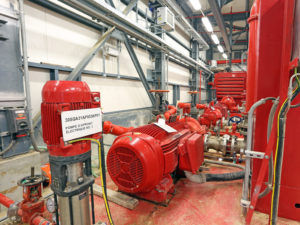All business owners know just how important it is to have a fire sprinkler system that is well-maintained. However, what they do not know is just how important it is to have a fire pump that is big enough to really support the fire sprinkler system. After all, your system will be useless if the water cannot reach your sprinklers because it is not large enough.
The first step in making sure that your fire pump is the correct size for your building is to  calculate your gallons per minute, as fire pumps are actually sized based on how much pressure they need. This pressure is measured in gallons per minute. There are two different methods of calculating your GPM:
calculate your gallons per minute, as fire pumps are actually sized based on how much pressure they need. This pressure is measured in gallons per minute. There are two different methods of calculating your GPM:
- Sprinkler Area Calculation – Considered the best way to size the fire sprinkler systems of large buildings, the sprinkler area calculation requires knowledge of the following sprinkler hazard classifications:
- Light hazard – a low amount of flammable materials and a generally low heat release (hospitals, churches, museums, offices)
- Ordinary hazard 1 – a moderate amount of flammable materials and a moderate heat release level (laundry facilities, commercial kitchens, etc.)
- Ordinary hazard 2 – a moderate heat release and moderate quantity of flammable materials (repair garages, stack rooms, stages)
- Extra hazard 1 – a high heat release with a high quantity of combustibles without any flammable liquids (saw mills and airplane hangars)
- Extra hazard 2 – flammable liquids, high heat release, and a high quantity of combustibles (plastics processing factories and flammable liquids spraying)
- Standpipe Method – The ideal method for smaller buildings, this system of piping is hooked to the firefighting hose and helps knock back fires in your building.
After the correct size fire pump is calculated for your building, the best type of pump must be selected from the three typical types:
- Inline fire pimps – Compact pumps that feature a space-saving design and low installation cost.
- Horizontal split case – The most commonly use pump on the market, these pumps will direct water to both sides of the impeller.
- Vertical turbine pumps – These pumps are typically used when the water supply is below the suction flange.
For more information on fire pumps and to have the right one installed at your business, contact A Total Solution, Inc. today!
